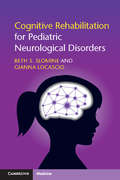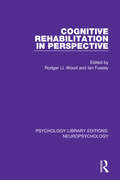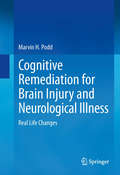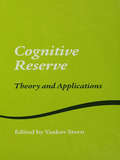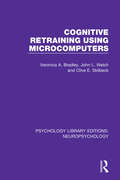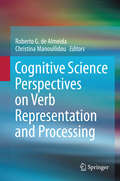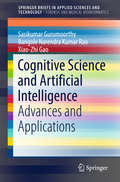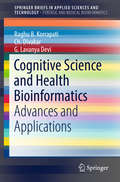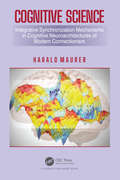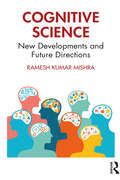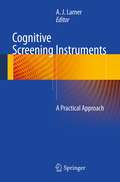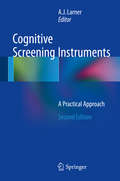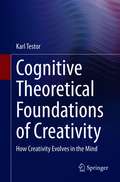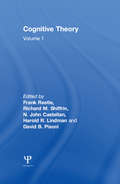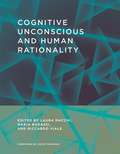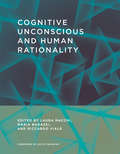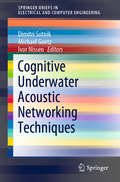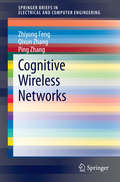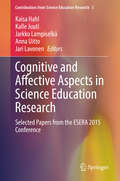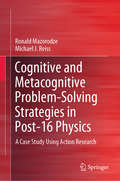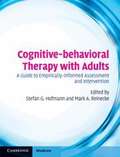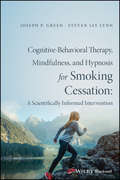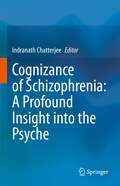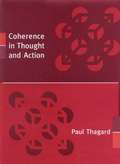- Table View
- List View
Cognitive Rehabilitation for Pediatric Neurological Disorders
by Gianna Locascio Beth S. SlomineResponding to expansion in the field of cognitive rehabilitation, this book offers a comprehensive review of interventions specifically for children and adolescents. Recent advances in research into pediatric cognitive rehabilitation make this a timely guide to the subject. Incorporating and reviewing current evidence to strengthen and consolidate the resource base for pediatric clinical care in cognitive rehabilitation, this book offers a reliable and engaging text for best practice. Systematic interventions to ameliorate the impact of cognitive difficulties following neurological injury, such as traumatic brain injury (TBI), stroke and brain tumor, can involve cognitive, behavioral, or pharmacologic methods. Case studies and practical guidance are included, to support the effective management and enhancement of cognitive recovery in children and adolescents. This book acts as a resource for professionals of all disciplines interested in understanding the existing evidence base for cognitive rehabilitation interventions for children and adolescents, featuring practical day-to-day professional support.
Cognitive Rehabilitation in Perspective (Psychology Library Editions: Neuropsychology #12)
by Rodger Ll. Wood Ian FusseyOriginally published in 1990, this book constitutes an objective evaluation of different cognitive rehabilitation techniques in relation to different types of brain injury at different stages of recovery. Various forms of cognitive rehabilitation are reviewed and clinical techniques are evaluated on the basis of their ability to restore functional independence or produce behaviour change, and improve aspects of cognitive ability.
Cognitive Remediation for Brain Injury and Neurological Illness: Real Life Changes
by Marvin H PoddThe purpose of this book is to teach psychologists with a neuropsychology background about cognitive remediation, the evidence in the research literature, and how to develop and conduct a treatment plan and evaluate the effectiveness of the interventions. The approach is illustrated using the computer-assisted cognitive remediation program developed by the author (NeurXercise). Twenty-nine different cases are presented in depth, following the outline presented in the earlier portions of the book. Treatment planning emphasizes Luria's concepts of alternate functional systems and double dissociation. Pre- and post-treatment neuropsychological testing results are presented along with ecological validity and generalization to daily functioning. The cases are presented by etiology and each section concludes with what can be learned about that etiologic process from the cognitive remediation results. This section includes blast injuries, which are still being characterized in the literature, as well as effective treatment of patients with head injury, stroke, post-neurosurgical sequelae, co-morbid disorders, subcortical disorders, attention deficit disorder, and learning disabilities. The book identifies the most commonly used neuropsychological test instruments for evaluating cognitive deficits, discusses their input and output characteristics, and does the same for the NeurXercise computer-based exercises so that the connection between testing and treatment is easy to see and develop. In addition to discussing this in the appropriate sections of the book, these are summarized in the appendixes as a reference for correlating test findings and appropriate exercises for remediating deficits.
Cognitive Reserve: Theory and Applications (Studies on Neuropsychology, Neurology and Cognition)
by Yaakov SternCognitive reserve has emerged as a powerful concept for interpreting individual differences in susceptibility to, and recovery from, brain injury or pathology. Underlying cognitive reserve is the idea that individual differences in how cognitive tasks are mediated in the brain allow some people to cope with pathology to a greater degree than others. Cognitive Reserve: Theory and Applications describes in depth the source of these individual differences. This volume provides a comprehensive review of theory, research and clinical application of the cognitive reserve. Chapters explore the theoretical underpinnings of cognitive reserve, and evidence for its existence. Various approaches for studying this concept are addressed, including epidemiologic, cognitive experimental, and neuroimaging. Possible genetic and physiologic underpinnings of cognitive reserve are presented. Application of this concept to a wide range of situations, including child development, aging, Alzheimer’s disease, stroke, HIV, and head injury is discussed. The result is an up-to-date, global treatment of cognitive reserve that will be of interest to someone new to the concept or the experienced investigator.
Cognitive Retraining Using Microcomputers (Psychology Library Editions: Neuropsychology #1)
by Veronica A. Bradley John L. Welch Clive E. SkilbeckOriginally published in 1993, the previous decade had seen considerable development in the field of neuropsychological rehabilitation following brain damage, and the use of computerized methods attracted attention and stimulated controversy. This practically-oriented text reviews representative examples from the literature at the time relating to the training of cognitive systems with the emphasis on studies describing the use of computerized methods. The topic is discussed in context and the contents include sections on cognitive change in neurological disorders, assessment techniques, the interaction between cognition and behaviour and the advantages and disadvantages of the use of microcomputers. The authors describe the evaluation of a computerized cognitive retraining programme run at the Regional Neurological Centre in Newcastle-upon-Tyne and draw on their experience of running such programmes to give practical guidance to those wishing to set up cognitive retraining programmes.
Cognitive Science 2nd Edition
by José Luis BermúdezThis exciting textbook introduces students to the dynamic vibrant area of Cognitive Science - the scientific study of the mind and cognition. Cognitive Science draws upon many academic disciplines, including Psychology, Computer Science, Philosophy, Linguistics and Neuroscience. This is the first textbook to present a unified view of Cognitive Science as a discipline in its own right, with a distinctive approach to studying the mind. Students are introduced to the cognitive scientist's 'toolkit' - the vast range of techniques and tools that cognitive scientists can use to study the mind. The book presents the main theoretical models that cognitive scientists are currently using, and shows how those models are being applied to unlock the mysteries of the human mind. Cognitive Science is replete with examples, illustrations, and applications, and draws on cutting-edge research and new developments to explore both the achievements that cognitive scientists have made, and the challenges that lie ahead.
Cognitive Science Perspectives on Verb Representation and Processing
by Roberto G. de Almeida Christina ManouilidouVerbs play an important role in how events, states and other "happenings" are mentally represented and how they are expressed in natural language. Besides their central role in linguistics, verbs have long been prominent topics of research in analytic philosophy--mostly on the nature of events and predicate-argument structure--and a topic of empirical investigation in psycholinguistics, mostly on argument structure and its role in sentence comprehension. More recently, the representation of verb meaning has been gaining momentum as a topic of research in other cognitive science branches, notably neuroscience and the psychology of concepts. The present volume is an expression of this recent surge in the investigation of verb structure and meaning from the interdisciplinary perspective of cognitive science, with up-to-date contributions by theoretical linguists, philosophers, psycholinguists and neuroscientists. The volume presents new theoretical and empirical studies on how verb structure and verb meaning are represented, how they are processed during language comprehension, how they are acquired, and how they are neurologically implemented. Cognitive Science Perspectives on Verb Representation and Processing is a reflection of the recent collaboration between the disciplines that constitute cognitive science, bringing new empirical data and theoretical insights on a key element of natural language and conceptualization.
Cognitive Science and Artificial Intelligence: Advances and Applications (SpringerBriefs in Applied Sciences and Technology)
by Xiao-Zhi Gao Sasikumar Gurumoorthy Bangole Narendra Kumar RaoThis book presents interdisciplinary research on cognition, mind and behavior from an information processing perspective. It includes chapters on Artificial Intelligence, Decision Support Systems, Machine Learning, Data Mining and Support Vector Machines, chiefly with regard to the data obtained and analyzed in Medical Informatics, Bioinformatics and related disciplines. The book reflects the state-of-the-art in Artificial Intelligence and Cognitive Science, and covers theory, algorithms, numerical simulation, error and uncertainty analysis, as well novel applications of new processing techniques in Biomedical Informatics, Computer Science and its applied areas. As such, it offers a valuable resource for students and researchers from the fields of Computer Science and Engineering in Medicine and Biology.
Cognitive Science and Health Bioinformatics: Advances and Applications (SpringerBriefs in Applied Sciences and Technology)
by Raghu B. Korrapati Ch. Divakar G. Lavanya DeviThis book highlights the interdisciplinary study of cognition, mind and behavior from an information processing perspective, and describes related applications to health informatics. The respective chapters address health problem-solving and education, decision support systems, user-centered interfaces, and the design and use of controlled medical terminologies. Reflecting cutting-edge research on computational methods - including theory, algorithms, numerical simulation, error and uncertainty analysis, and their applications - the book offers a valuable resource for doctoral students and researchers in the fields of Computer Science and Engineering.
Cognitive Science: Integrative Synchronization Mechanisms in Cognitive Neuroarchitectures of Modern Connectionism
by Harald MaurerThe Mind and Brain are usually considered as one and the same nonlinear, complex dynamical system, in which information processing can be described with vector and tensor transformations and with attractors in multidimensional state spaces. Thus, an internal neurocognitive representation concept consists of a dynamical process which filters out statistical prototypes from the sensorial information in terms of coherent and adaptive n-dimensional vector fields. These prototypes serve as a basis for dynamic, probabilistic predictions or probabilistic hypotheses on prospective new data (see the recently introduced approach of "predictive coding" in neurophilosophy). Furthermore, the phenomenon of sensory and language cognition would thus be based on a multitude of self-regulatory complex dynamics of synchronous self-organization mechanisms, in other words, an emergent "flux equilibrium process" ("steady state") of the total collective and coherent neural activity resulting from the oscillatory actions of neuronal assemblies. In perception it is shown how sensory object informations, like the object color or the object form, can be dynamically related together or can be integrated to a neurally based representation of this perceptual object by means of a synchronization mechanism ("feature binding"). In language processing it is shown how semantic concepts and syntactic roles can be dynamically related together or can be integrated to neurally based systematic and compositional connectionist representations by means of a synchronization mechanism ("variable binding") solving the Fodor-Pylyshyn-Challenge. Since the systemtheoretical connectionism has succeeded in modeling the sensory objects in perception as well as systematic and compositional representations in language processing with this vector- and oscillation-based representation format, a new, convincing theory of neurocognition has been developed, which bridges the neuronal and the cognitive analysis level. The book describes how elementary neuronal information is combined in perception and language, so it becomes clear how the brain processes this information to enable basic cognitive performance of the humans.
Cognitive Science: New Developments and Future Directions
by Ramesh Kumar MishraThis volume provides an overview of cognitive science and critically assesses areas within the topic that are evolving rapidly. Using multidisciplinary studies and rich empirical literature, discussions, and demonstrations, this book: • Discusses the evolution of cognition with reference to material records and the use of brain imaging • Highlights emerging domains and novel themes within cognitive science such as transgender cognition, space cognition, cross-cultural cognition, futuristic artificial intelligence, social cognition and moral cognition • Reflects on the status of cognition research in these emerging areas and critically evaluates their current progress • Explores data both from behavioural and neuroimaging research literature, and sheds light on the potential effects of technological growth and changing habits on attention and cognitive abilities of humans • Examines the effects of religious and meditative practices on its core cognitive science components • Speculates research domains that would gain importance in the next few decades in cognitive science research Finding commonalities in theoretical frameworks and models in upcoming areas in cognition research, this comprehensive study will be of interest to students, researchers and teachers of cognitive psychology, cognitive science, neuroscience, medical science and computer science. It will also be helpful for academicians, psychologists, neuroscientists, mental health professionals, medical professionals, counsellors and those looking for an alternate perspective on the topic.
Cognitive Screening Instruments: A Practical Approach
by A. J. LarnerCognitive Screening Instruments: A Practical Approach provides a practical and structured overview of some of the most commonly used and easily available cognitive screening instruments applicable in the outpatient clinic and bedside setting. Dementia and cognitive disorders are now recognised as an increasing public health problem, both in terms of patient numbers and cost, as populations age throughout the world. Despite this, many patients with dementia never receive a formal diagnosis, with implications for their appropriate care and management. Diagnostic tests which identify cases of dementia therefore have an important role. Expert authors from around the world equip the reader of Cognitive Screening Instruments: A Practical Approach with clear instructions on the usage of each screening instrument, its strengths and weaknesses, the time required for administration, and rules on scoring, such as how to correct for variations in the patient's age or education, and suggested cut-off scores. Cognitive Screening Instruments: A Practical Approach is a handy, illustrated guide and a valuable diagnostic aid for practitioners working closely with patients with dementia and mild cognitive impairment. This volume will be of use both to clinicians and to professionals in disciplines allied to medicine who are called upon to assess patients with possible cognitive disorders, including neurologists, old age psychiatrists, neuropsychologists, primary care physicians, dementia support workers, and members of memory assessment teams.
Cognitive Screening Instruments: A Practical Approach
by A. J. LarnerCognitive Screening Instruments: A Practical Approach provides a practical and structured overview of some of the most commonly used and easily available cognitive screening instruments applicable in the outpatient clinic and bedside setting. Dementia and cognitive disorders are now recognised as an increasing public health problem, both in terms of patient numbers and cost, as populations age throughout the world. Despite this, many patients with dementia never receive a formal diagnosis, with implications for their appropriate care and management. Diagnostic tests which identify cases of dementia therefore have an important role. Expert authors from around the world equip the reader of Cognitive Screening Instruments: A Practical Approach with clear instructions on the usage of each screening instrument, its strengths and weaknesses, the time required for administration, and rules on scoring, such as how to correct for variations in the patient's age or education, and suggested cut-off scores. Cognitive Screening Instruments: A Practical Approach is a handy, illustrated guide and a valuable diagnostic aid for practitioners working closely with patients with dementia and mild cognitive impairment. This volume will be of use both to clinicians and to professionals in disciplines allied to medicine who are called upon to assess patients with possible cognitive disorders, including neurologists, old age psychiatrists, neuropsychologists, primary care physicians, dementia support workers, and members of memory assessment teams.
Cognitive Theoretical Foundations of Creativity: How Creativity Evolves in the Mind
by Karl TestorHow does creativity evolve in mind? This question leads a journey through neuroanatomical understanding and cognitive models. It thereby helps to figure out new approaches in decoding the process of creativity. These “aspects of the new” provide better understanding and constitute future research and insight of cognitive activities and creativity.
Cognitive Theory: Volume 1: Cognitive Theory
by F. RestleFirst published in 1982. This book contains the content of the Indiana Conference of 1974. This Conference has met for each of the last seven years. At one time it was known as the Midwestern Mathematical Psychology Meeting, but as interest drifted toward more experimental and theoretical, but less purely mathematical work, the title became the Indiana Theoretical and Cognitive Psychology Meetings. The contributors to this Conference were requested to emphasize the relatively broad theoretical significance of their work, to incorporate the work of others, and if they were willing, to speculate about future developments
Cognitive Unconscious and Human Rationality
by Keith Frankish Riccardo Viale Laura Macchi Maria BagassiThis volume contributes to a current debate within the psychology of thought that has wide implications for our ideas about creativity, decision making, and economic behavior. The essays focus on the role of implicit, unconscious thinking in creativity and problem solving, the interaction of intuition and analytic thinking, and the relationship between communicative heuristics and thought. The analyses move beyond the conventional conception of mind informed by extra-psychological theoretical models toward a genuinely psychological conception of rationality -- a rationality no longer limited to conscious, explicit thought, but able to exploit the intentional implicit level.The contributors consider a new conception of human rationality that must cope with the uncertainty of the real world; the implications of abandoning the normative model of classic logic and adopting a probabilistic approach instead; the argumentative and linguistic aspects of reasoning; and the role of implicit thought in reasoning, creativity, and its neurological base.ContributorsMaria Bagassi, Linden J. Ball, Jean Baratgin, Aron K. Barbey, Tilmann Betsch, Eric Billaut, Jean-François Bonnefon, Pierre Bonnier, Shira Elqayam, Keith Frankish, Gerd Gigerenzer, Ken Gilhooly, Denis Hilton, Anna Lang, Stefanie Lindow, Laura Macchi, Hugo Mercier, Giuseppe Mosconi, Ian R. Newman, Mike Oaksford, David Over, Guy Politzer, Johannes Ritter, Steven A. Sloman, Edward J. N. Stupple, Ron Sun, Nicole H. Therriault, Valerie A. Thompson, Emmanuel Trouche-Raymond, Riccardo Viale
Cognitive Unconscious and Human Rationality
by Riccardo Viale Laura Macchi Maria BagassiExamining the role of implicit, unconscious thinking on reasoning, decision making, problem solving, creativity, and its neurocognitive basis, for a genuinely psychological conception of rationality. This volume contributes to a current debate within the psychology of thought that has wide implications for our ideas about creativity, decision making, and economic behavior. The essays focus on the role of implicit, unconscious thinking in creativity and problem solving, the interaction of intuition and analytic thinking, and the relationship between communicative heuristics and thought. The analyses move beyond the conventional conception of mind informed by extra-psychological theoretical models toward a genuinely psychological conception of rationality—a rationality no longer limited to conscious, explicit thought, but able to exploit the intentional implicit level.The contributors consider a new conception of human rationality that must cope with the uncertainty of the real world; the implications of abandoning the normative model of classic logic and adopting a probabilistic approach instead; the argumentative and linguistic aspects of reasoning; and the role of implicit thought in reasoning, creativity, and its neurological base.ContributorsMaria Bagassi, Linden J. Ball, Jean Baratgin, Aron K. Barbey, Tilmann Betsch, Eric Billaut, Jean-François Bonnefon, Pierre Bonnier, Shira Elqayam, Keith Frankish, Gerd Gigerenzer, Ken Gilhooly, Denis Hilton, Anna Lang, Stefanie Lindow, Laura Macchi, Hugo Mercier, Giuseppe Mosconi, Ian R. Newman, Mike Oaksford, David Over, Guy Politzer, Johannes Ritter, Steven A. Sloman, Edward J. N. Stupple, Ron Sun, Nicole H. Therriault, Valerie A. Thompson, Emmanuel Trouche-Raymond, Riccardo Viale
Cognitive Underwater Acoustic Networking Techniques (SpringerBriefs in Electrical and Computer Engineering)
by Michael Goetz Ivor Nissen Dimitri SotnikThis book summarizes the latest research on cognitive network-layer methods and smart adaptive physical-layer methods in underwater networks. Underwater communication requires extendable and delay-tolerant underwater acoustic networks capable of supporting multiple frequency bands, data rates and transmission ranges. The book also discusses a suitable foreground communication stack for mixed mobile/static networks, a technology that requires adaptive physical layer waveforms and cognitive network strategies with underlying cooperative and non-cooperative robust processes. The goal is to arrive at a universally applicable standard in the area of Underwater Internet-of-Things [ISO/IEC 30140, 30142, 30143].
Cognitive Wireless Networks (SpringerBriefs in Electrical and Computer Engineering)
by Ping Zhang Zhiyong Feng Qixun ZhangThis brief examines the current research in cognitive wireless networks (CWNs). Along with a review of challenges in CWNs, this brief presents novel theoretical studies and architecture models for CWNs, advances in the cognitive information awareness and delivery, and intelligent resource management technologies. The brief presents the motivations and concepts of CWNs, including theoretical studies of temporal and geographic distribution entropy as well as cognitive information metrics. A new architecture model of CWNs is proposed with theoretical, functional and deployment architectures supporting cognitive information flow and resource flow. Key technologies are identified to achieve the efficient cognitive information awareness and delivery. The brief concludes by validating the effectiveness of proposed theories and technologies using the CWNs testbed and discussing the importance of standardization practices. The context and analysis provided by this text are ideal for researchers and practitioners interested in wireless networks and cognitive information. Cognitive Wireless Networks is also valuable for advanced-level students studying resource management and networking.
Cognitive and Affective Aspects in Science Education Research: Selected Papers from the ESERA 2015 Conference (Contributions from Science Education Research #3)
by Kaisa Hahl Kalle Juuti Jarkko Lampiselkä Anna Uitto Jari LavonenThis edited volume brings forth intriguing, novel and innovative research in the field of science education. The chapters in the book deal with a wide variety of topics and research approaches, conducted in various contexts and settings, all adding a strong contribution to knowledge on science teaching and learning. The book is comprised of selected high-quality studies that were presented at the 11th European Science Education Research Association (ESERA) Conference, held in Helsinki, Finland from 31 August to 4 September, 2015. The ESERA science education research community consists of professionals with diverse disciplinary backgrounds from natural sciences to social sciences. This diversity provides a rich understanding of cognitive and affective aspects of science teaching and learning in this volume. The studies in this book will invoke discussion and ignite further interest in finding new ways of doing and researching science education for the future and looking for international partners for both science education and science education research. The twenty-five chapters showcase current orientations of research in science education and are of interest to science teachers, teacher educators and science education researchers around the world with a commitment to evidence-based and forward-looking science teaching and learning.
Cognitive and Metacognitive Problem-Solving Strategies in Post-16 Physics: A Case Study Using Action Research (SpringerBriefs in Education)
by Michael J. Reiss Ronald MazorodzeThis book reports on a study on physics problem solving in real classrooms situations.Problem solving plays a pivotal role in the physics curriculum at all levels. However, physics students’ performance in problem solving all too often remains limited to basic routine problems, with evidence of poor performance in solving problems that go beyond equation retrieval and substitution. Adopting an action research methodology, the study bridges the `research-practical divide´ by explicitly teaching physics problem-solving strategies through collaborative group problem-solving sessions embedded within the curriculum. Data were collected using external assessments and video recordings of individual and collaborative group problem-solving sessions by 16-18 year-olds. The analysis revealed a positive shift in the students’ problem-solving patterns, both at group and individual level. Students demonstrated a deliberate, well-planned deployment of the taught strategies. The marked positive shifts in collaborative competences, cognitive competences, metacognitive processing and increased self-efficacy are positively correlated with attainment in problem solving in physics. However, this shift proved to be due to different mechanisms triggered in the different students.
Cognitive-Behavioral Therapy with Adults
by Stefan G. Hofmann Mark A. ReineckeCognitive-behavioural therapy has developed hugely over the past 30 years and is the branch of psychotherapy which has most successfully transferred into the mainstream of treating mental health problems. In this volume, readers will be provided with an integrated, systematic approach for conceptualizing and treating disorders commonly encountered in clinical practice. A strong emphasis is placed on empirically supported approaches to assessment and intervention while offering readers hands-on recommendations for treating common mental disorders, grounded in evidence-based medicine. Practical chapters written by a variety of international experts include numerous case studies demonstrating the specific techniques and addressing common problems encountered and how to overcome them. Cognitive-behavioural Therapy with Adults is an essential guide for practising clinicians and students of cognitive-behavioural therapy as well as educated consumers and those interested in psychotherapy for common mental disorders.
Cognitive-Behavioral Therapy, Mindfulness, and Hypnosis for Smoking Cessation: A Scientifically Informed Intervention
by Steven Jay Lynn Joseph P. GreenCognitive-Behavioral Therapy, Mindfulness, and Hypnosis for Smoking Cessation: A Scientifically Informed Intervention presents a comprehensive program developed by noted experts to help smokers achieve their goal of life-long abstinence from smoking. This brief, cost-effective intervention, called The Winning Edge, incorporates state-of-the-science advances and best clinical practices in the treatment of tobacco addiction and offers participants a unique blend of strategies based on cognitive-behavioral, mindfulness, and hypnotic approaches to achieve smoking cessation. This valuable treatment guide, developed and refined over the past 30 years, provides all of the information necessary for health care providers to implement the program on a group or individual basis. <p><p> This important resource: <p><p> Provides a detailed, step-by-step guide to conducting the program, with scripts for providers and handouts for participants Explains the scientific basis for the many strategies of cognitive, behavioral, and affective change in The Winning Edge program Contains information for treatment providers on frequently asked questions, adapting and tailoring the program to the needs of participants, and overcoming challenges, ambivalence, and resistance to stop smoking <p><p>Written for a wide audience of mental health professionals, Cognitive-Behavioral Therapy, Mindfulness, and Hypnosis for Smoking Cessation: A Scientifically Informed Intervention offers a comprehensive, science-based approach to help participants achieve their goal of a smoke-free life.
Cognizance of Schizophrenia:: A Profound Insight into the Psyche
by Indranath ChatterjeeThis book provides the reader with a thorough understanding of schizophrenia as a complex brain disorder by explaining the various aspects investigated for its cognizance from epigenetics to chemistry and physics to computational approaches. The book covers the key notions of schizophrenia from a variety of facets such as neurogenetics, neurochemistry, neuropharmacology, neurobiology, psychotherapy, psychiatric treatment, cognitive studies, behavioral and societal studies, and computational neurosciences. Individual chapters are focused on crucial topics such as cognitive-behavioral therapy, brain functioning, computational neuroscience, neuro-imaging, and many more. This book explains each section and chapter with utmost clarity to maintain comprehensiveness for every kind of reader. This book covers various classical as well as recent topics from basic to advance level knowledge regarding schizophrenia. The book's contributions regarding its inclusivity of topics, comprehensiveness of language, diversity in knowledge, and focus on the subject will attract all kinds of readers. It can be considered a single comprehensive handy reference book for beginners, including medical students, neuroscientists, researchers, clinicians, and medical practitioners. Cognizance of Schizophrenia will be an invaluable asset for all who are involved in neuroscience research or clinical studies.
Coherence in Thought and Action
by Paul ThagardThis book is an essay on how people make sense of each other and the world they live in. Making sense is the activity of fitting something puzzling into a coherent pattern of mental representations that include concepts, beliefs, goals, and actions. Paul Thagard proposes a general theory of coherence as the satisfaction of multiple interacting constraints, and discusses the theory's numerous psychological and philosophical applications. Much of human cognition can be understood in terms of coherence as constraint satisfaction, and many of the central problems of philosophy can be given coherence-based solutions. Thagard shows how coherence can help to unify psychology and philosophy, particularly when addressing questions of epistemology, metaphysics, ethics, politics, and aesthetics. He also shows how coherence can integrate cognition and emotion.
